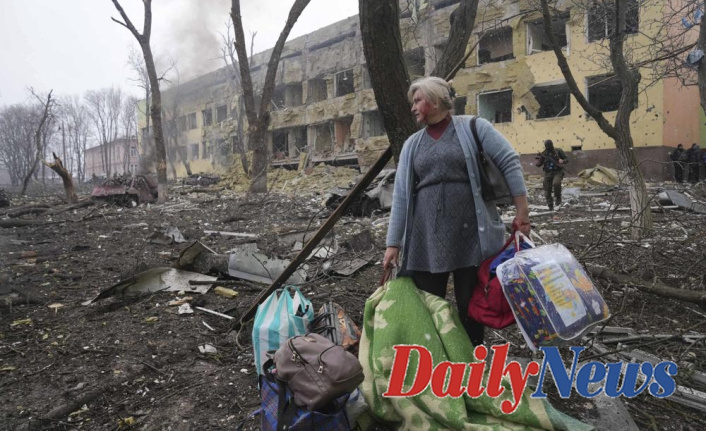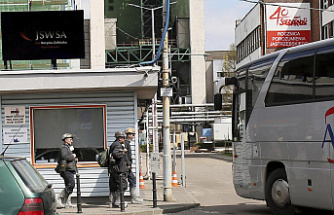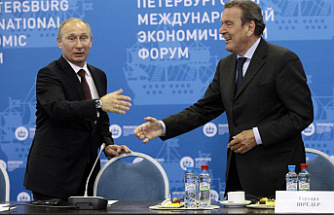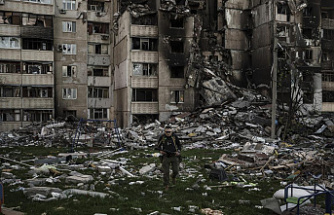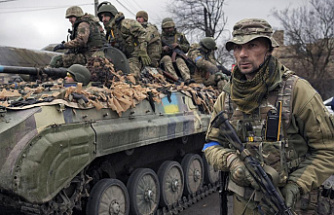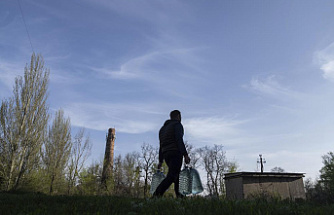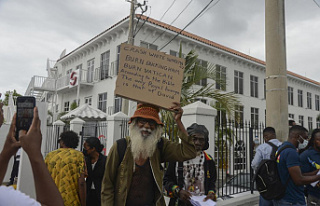The most violent military conflict in Europe since World War II also disrupted the international security order, sending dangerous ripples through global economy.
A month later, pivotal moments of conflict
THE ROAD TO WAR
A buildup of Russian troops close to Ukraine in the early 2021 raised concerns about an offensive. Some of these forces were withdrawn by Moscow in April. This opened the door to a summit between President Joe Biden (Russia) and Vladimir Putin (Russia). However, their meeting did not result in a significant decrease in tensions between Russia and the United States.
The Russian military built up a new force along the Ukrainian border in October. It reached 150,000 troops by year's end. Moscow denies any plans to attack Ukraine from the start of the troop surge. It called such Western concerns part a campaign against Russia. It also urged the U.S. to prevent Ukraine joining NATO and to rebalance the alliance forces from Eastern Europe. These were demands that the West rejected.
On February 21, Putin abruptly increased the pressure by recognizing pro-Russian rebel areas in eastern Ukraine. Since 2014, insurgents have been fighting Ukrainian forces in the region. The mass protests that drove out Ukraine's Moscow-friendly president forced him from office. Russia then annexed the Crimean Peninsula.
INVASION BEGINS
On February 24, Putin declared the beginning of a "special military operations" to demilitarize Ukraine, and expel alleged "neoNazi nationalists." Russian troops entered Ukraine via Crimea, in the south, and all the way to the east, as well as from Moscow's ally Belarus which borders Ukraine in its north.
Putin claimed that Russia was forced to act because Washington and its allies had ignored its request for security guarantees. The claims were dismissed by the West as a pretext for the attack.
The Russian military moved on the Ukrainian capital Kyiv.located only 75 km (47 miles) from the border with Belarus. It closed in on Kharkiv, the second-largest city in Ukraine, in the east, and pushed on to the Sea of Azov coasts in south.
Russia claimed that it was only attacking military facilities. However, artillery and air strikes were used to attack residential areas, schools, and hospitals throughout Ukraine.
March was a particularly tragic month for the assault:
On March 1, a Russian missile struck the Kharkiv regional administration building, killing 24,
A Russian airstrike on March 9 destroyed a maternity facility in the besieged port city of Mariupol, injuring 17 and killing at least 3.
A Russian bomb exploded on March 16 in Mariupol. This happened despite the fact that Ukrainians had written the word "children" in large white letters next to the pavement to indicate that civilians were hiding inside. Officials claimed that hundreds of people were hiding in the basement.
At least 8 people were killed in a Russian airstrike that struck a shopping center in Kyiv.
Russia's most important objective in the South is Mariupol, on the Sea of Azov. This city has been under siege since. The Russians have relentlessly bombarded entire areas and killed thousands of civilians, making the city a symbol of civil suffering.
Many have fled the city as part of a wave of refugees fleeing from the country. Officials at the United Nations estimate to be more than 3.5million.
RUSSIA IS STUNG BY WESTERN SANCTIONIONS
The invasion was quickly met with unprecedented financial and economic sanctions by the Western Allies.
Numerous waves of severe penalties frozen an estimated half the $640 billion Russian hard-currency reserves. They also cut off key Russian banks from the SWIFT financial messaging network. Moscow was prohibited from receiving cash in dollars or euros. Widely regulated trade areas were also targeted by the Russian government. Large international companies quickly left the Russian market.
These severe measures, which were previously only taken against Iran and North Korea, sent the ruble plummeting and provoked panic among consumers.
Russian authorities responded by tightening restrictions on hard currency transactions and stock market trading.
UKRAINE PLADES FOR MORE WEAPONS, No-Fly ZONE
While hailing Western weapons supplies and sanctions, the Ukrainian President Volodymyr Zilenskyy challenged the U.S. to take stronger steps to stop Russia.
He has repeatedly urged NATO and the U.S. to declare no-fly zones over Ukraine. This request was rejected by the allies for fear of a direct confrontation with Russia or sparking a conflict.
Zelenskyy has also pleaded with Western allies for Ukraine to receive warplanes as well as long-range air defense system. Russia has warned the West to not make such a move. Discussions on possible delivery of Soviet-era fighter planes and air defense weapons to Ukraine from Eastern Europe have been stalled while the West seeks to avoid an escalation.
The U.S. and EU have been asked to increase sanctions to include a ban Russian oiland gasoline exports. This move is opposed by many EU member countries that rely on Russia for large amounts of their energy.
RUSSIAN OFFENSIVE BOGS DOWN
The invasion didn't go as planned from the beginning. After rapidly advanced to the outskirts Kyivin just a few days, Russian troops quickly became entrapped in the suburbs.
The Kremlin wanted Ukraine to surrender, but instead, the troops of the country fought back in every sector. This stopped Russian attempts at quickly advancing into large cities like Kharkiv or Chernihiv. Russia also failed to take full control of Ukraine's skies despite heavy strikes against its air force and air defense systems.
Russian military convoys stretched for many kilometers (miles) along the highway that leads from Belarus. They have become an easy target for raids, ambushes, and other attacks. The Russian troops in the east have had to confront reinforced Ukrainian positions in rebel areas and only made incremental gains.
Despite their control over Mariupol, and the quick capture of the ports Berdyansk & Kherson, the Russians failed to capture Mykolaiv, a key shipbuilding center. They are now pushing the offensive west towards Odesa.
Officials from the West claim that Russia has been suffering from persistent shortages of food and fuel, and is unable to obtain proper cold weather gear.
The Russian military reported that 498 soldiers had been killed in March. However, they never updated their toll. NATO, however, stated that between 7,000 and 15,000 Russian troops had been killed in just four weeks. The Soviet Union lost approximately 15,000 troops in a period of 10 years during the war on Afghanistan.
NUCLEAR THREATS CHEMICAL WEAPONS FEAR
Concerns about the safety and security of Ukraine's nuclear power stations were raised by the war.
The decommissioned Chernobyl nuclear power plant was taken over by Russian forces on the first day. It was the site of the worst nuclear accident in history, 36 years ago. They seized the Zaporizhzhia nuke power plant, Europe’s largest. This set off a firestorm that raised concerns about a possible catastrophe. According to the Ukrainian state agency that oversees the Chernobyl exclusion area, Russian military forces destroyed the Chernobyl new laboratory.
Other concerns about chemical leaks have also been raised.
An ammonia leak from a chemical plant in Sumy, eastern Ukraine, occurred on March 21st. It contaminated an area of 2.5 km (1.5 miles) in radius but did not cause any harm to civilians living in the city of 263,000.
Russian military repeatedly claimed that Ukrainian "nationalists” are plotting to destroy a nuclear or chemical facility. Then they blame the Russians. Warnings that Western officials fear could signal an attack by Russia.
Many Western countries fear that Putin might order the use of chemical weapons or tactical nuclear weapons in an attempt to spread fear and bring down Ukraine.
WHAT'S NEXT?
Putin does not appear to be backing down, even as his offensive fails and the Russian economy is shattered by Western sanctions.
Russian polls support Putin despite the falling ruble and rising consumer prices. These results are attributed by observers to the Kremlin’s massive propaganda campaign against dissent.
Putin wants Ukraine to adopt a neutral status and to drop its bid for NATO membership. He also demands that Ukraine demilitarize, recognize Russia’s sovereignty over Crimea, and acknowledge the independence from the rebel republics of the Donbas.
Zelenskyy stated earlier this week Ukraine is open to discussing a neutral status and security guarantees that would prevent any further aggression. However, he said that the status of Crimea or the separatist areas could only be discussed after a ceasefire was reached and Russian troops are withdrawn.
Putin might be trying to gain more ground, and to negotiate from a position that is strong enough to force Zelenskyy to make concessions. Russian and Ukrainian negotiators claim they are far from reaching a potential deal that Putin or Zelenskyy might discuss.

